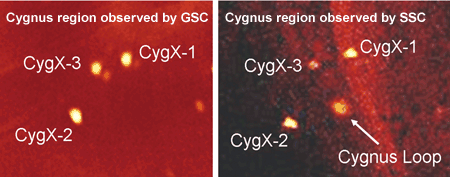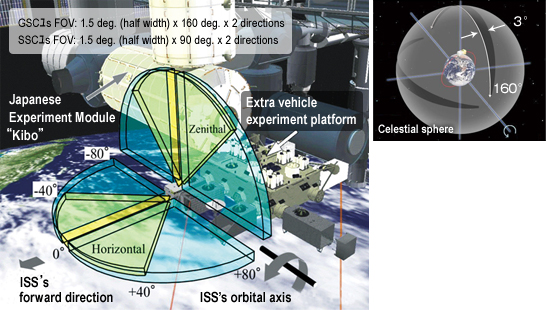TOP > Report & Column > The Forefront of Space Science > 2009 > Monitor of All-sky X-ray Image (MAXI) Starting to Watch the Dynamically Changing Universe
![]()

On the other hand, we adjusted the driving and data-processing parameters of the SSC in operation to improve its observation efficiency. Fig. 2 shows the Cygnus region observed by GSC and SSC. Only SSC with its sensitivity to low-energy X-ray photons can clearly identify the supernova remnant called Cygnus Loop. By making full use of its sensitivity extending to the low-energy region and its high energy-resolution capability, SSC could significantly contribute to the production of a gas distribution map that spreads widely throughout the universe and to the observation of many celestial objects, in particular, ones that are bright in low-energy side. Researchers around the world anticipate that MAXI will play a significant role as an ďeye to see all the skyĀEin the following two years at least (the target is five years). Once every 90 minutes, MAXI monitors changes in X-ray intensity and energy spectrum (color) of more than a thousand X-ray objects in all the sky from one day to several months. It is the first attempt to systematically monitor active extragalactic objects such as quasars over this time scale. It is expected that, with its repeated, continued observations hereafter, MAXI will attain ten times the sensitivity of the existing All-Sky Monitor (i.e. ASM onboard the X-ray astronomical satellite RXTE). The international expectation is that MAXI will assume the RXTE/ASMís role. 
Detection of brightness-increasing objects with MAXI Currently, we are calibrating MAXI as a priority so that it can determine accurately the position and energy strength of X-ray objects, accumulating observational data at the same time. For objects with increasing brightness, however, we analyze them immediately. When the results are important, we report them via the urgent announcement mailing lists of the international astronomy community. Here are some examples: On Aug. 21, 2009, an object that was temporarily and strongly brightening in the MAXI image was discovered (Fig. 3) by a team member, while using software to locate a suddenly brightening object in MAXIís observational data (hereinafter, the ďnova search systemĀE. The data was immediately analyzed by students of Aoyama Gakuin University and Nihon University. As a result, we concluded that this was the X-ray burst of a body designated as 4U1724-307. X-ray burst is a sudden brightening event caused by thermonuclear fusion of gases (mainly helium) accumulated on the surface of neutron stars. The bursts last for a few seconds to tens of seconds. The observed burst was so bright that it was identified even by observation in more than 10k electron volt X-ray photons. Thus, with this observation, MAXI showed its capability to exceed any previous X-ray all-sky monitor (e.g., RXTE/ASM). 
MAXI sees almost the entire sky in about 90 minutes with its narrow and long field of view as shown in Fig. 4. Short-duration brightening events would be detected only if they happen within view of MAXI. Brightening events that MAXI can detect without fail are ones that continue to brighten for more than tens of minutes. One such example is super bursts which have been reported by other satelliteís observations. The duration of super bursts, whose energy radiation amount reaches up to 1,000 times that of ordinary X-ray bursts, is from tens of minutes to tens of hours. Accordingly, such events are candidates to be observed successfully by MAXI. 
|
||||||||||||||




